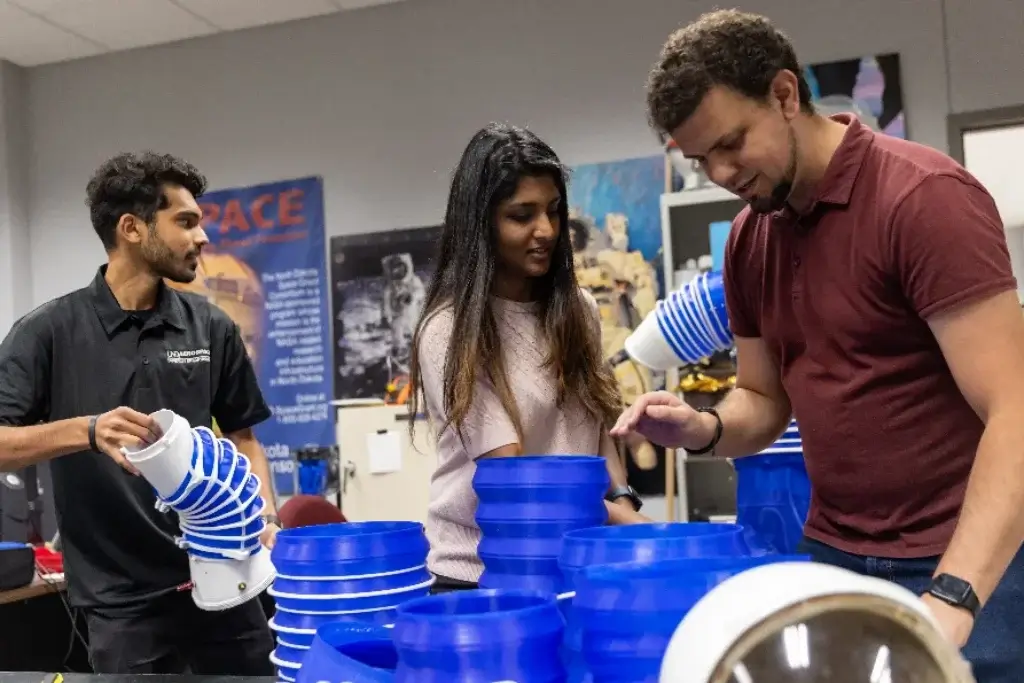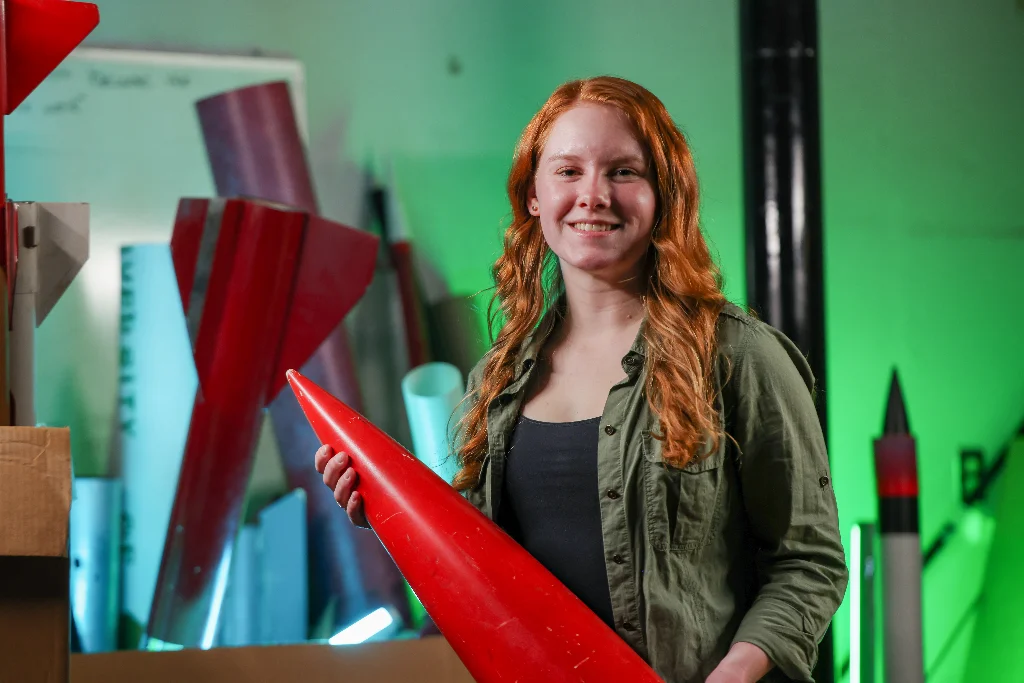
What is Aerospace Engineering?
Just over a century ago, in the early 1900s, a machine known as the Wright Flyer made history.
Request Information
On a chilly December day, this contraption, crafted by the Wright brothers, soared into the air, marking the world's first powered, manned, heavier-than-air and controlled flight. The flight itself was brief—lasting only 12 seconds and covering a mere 121 feet—but its impact on human achievement would be monumental and everlasting.
Fast-forward to 2024 and the landscape of aviation and space exploration has transformed dramatically. Gone are the days of tentative, short flights over sand dunes; instead, our week is dotted with multiple space missions launched by various aerospace companies reaching for the stars. This astonishing evolution in aerospace capabilities over a relatively short period is largely thanks to groundbreaking advancements in aerospace engineering.
But what is aerospace engineering? Read on as we explore this fascinating field, its transformative role in shaping the past and future of transportation and the career paths it offers. Whether you're a student pondering a future in engineering or simply curious about how human beings have managed to conquer the skies and probe the cosmos, keep reading to learn more about this branch of engineering.
What is Aerospace Engineering?
Aerospace engineering is an advanced field of engineering that focuses on the design, development, testing and maintenance of aircraft and spacecraft. It encompasses both aeronautical engineering (which pertains solely to aircraft) and astronautical engineering (which focuses on spacecraft).
The overarching goal of aerospace engineering is to improve systems and vehicles that operate within Earth's atmosphere and to pioneer technologies for space exploration and other planetary atmospheres.
The Importance of Aerospace Engineering
Aerospace engineering extends its influence beyond flight and space exploration, impacting many critical aspects of modern life and global society. At the forefront of technological innovation, this field is crucial in developing advanced technologies for exploration, such as the rovers on Mars and probes sent to comets, which not only expand our understanding of the universe but also stimulate further technological advancements here on Earth.
The significance of aerospace engineering is also crucial in defense and security. It underpins the development of sophisticated defense systems, including stealth fighters like the F-35 and unmanned aerial vehicles like the MQ-9 Reaper. These systems, which rely on advanced aerodynamics, propulsion and sensory technologies, are essential for modern warfare and surveillance, enhancing efficiency and safety.
Additionally, aerospace engineering plays a vital role in global connectivity and communication. By deploying communication satellites, such as those from the OneWeb and Starlink projects, aerospace engineering enables broadband access in the most remote areas, supports mobile networks and facilitates global broadcasting, effectively shrinking the world and enhancing global communication.
The field is also indispensable in weather monitoring and disaster management. Weather satellites like those in NOAA's GOES series provide critical data for forecasting severe weather, aiding disaster preparedness and emergency response. Similarly, Earth observation satellites monitor environmental changes and manage responses to natural disasters, providing real-time data crucial for addressing wildfires, floods and other emergencies.
Branches of Aerospace Engineering
Aerospace engineering is a broad field encompassing several specialized branches, each dedicated to different aspects of airspace and space exploration.
Aeronautical Engineering
Aeronautical engineering focuses on the science, technology and methodologies of aircraft that operate within Earth's atmosphere. Aeronautical engineers design, construct and test aircraft to ensure optimal performance, safety and compliance with regulatory standards. They work on various vehicles, including airplanes, helicopters, gliders and drones. The principles of aerodynamics, propulsion and structural analysis are at the core of aeronautical engineering.

Astronautical Engineering
On the other hand, astronautical engineering applies science and engineering to the design, development and analysis of spacecraft. This branch extends beyond the Earth's atmosphere to include satellites, rockets, space stations and other equipment that operate in outer space.
Astronautical engineers face unique challenges such as microgravity, extreme temperature variations and the vacuum of space, all of which require innovative solutions for successful space exploration.
Avionics Engineering
Avionics engineering studies electronic systems used on aircraft, artificial satellites and spacecraft. It includes components critical to the vehicle's operation, such as communication, navigation as well as the display and management of multiple systems. Advanced avionics development enhances the safety and efficiency of air and space travel and supports the automation of in-flight tasks.
Roles and Responsibilities of Aerospace Engineers
Aerospace engineers play a crucial role in developing and advancing aircraft and spacecraft, tackling complex challenges that require a high level of expertise and dedication. Their primary duties and responsibilities include:
- Designing aircraft, spacecraft, satellites and missiles, ensuring that all specifications meet exacting standards for safety, efficiency and regulatory compliance
- Conducting rigorous testing on prototypes and parts to evaluate the feasibility, safety and functionality of designs
- Ensuring the ongoing operational capabilities of aircraft and spacecraft through regular maintenance, troubleshooting and updates to systems and components
- Researching and developing new technologies and materials
- Integrating complex systems within aircraft and spacecraft, such as propulsion, electrical and hydraulic systems
- Leading or participating in multidisciplinary project teams
- Ensuring compliance with safety standards and regulations
- Minimizing the environmental impact of aerospace vehicles through cleaner propulsion technologies and more efficient designs
How to Become an Aerospace Engineer
Aspiring engineers prepare for their roles by pursuing a bachelor's degree in a relevant field that covers the fundamental principles of aerospace engineering. Aerospace engineering degree programs are typically the standard choice, although students may also enter the field through mechanical, electrical or materials engineering degrees.
Upon completing the undergraduate program, pursuing a master's or doctoral degree can be particularly beneficial, especially for those interested in specialized research roles or academic positions.
Hands-on experience is also invaluable in aerospace engineering. Internships, co-op programs and participation in research projects provide practical experience and help students develop their engineering skills in real-world environments. These opportunities allow aspiring engineers to apply theoretical knowledge to actual engineering problems and learn from experienced professionals in the field.
Additionally, while not always mandatory, obtaining professional certifications can significantly enhance an aerospace engineer's credentials as they demonstrate expertise and commitment to the profession. In some regions, aerospace engineers may also pursue licensure as a Professional Engineer (PE), which involves meeting specific education and experience requirements and passing an exam. This license is essential for those who approve design plans or oversee other engineers and is a mark of professionalism and competence.
Where Do Aerospace Engineers Work?
Aerospace engineers have a diverse range of employment opportunities across various industries, thanks to their specialized skill set and the versatile applications of their expertise. They can be found working in:
- Aerospace and defense companies: Designing and manufacturing aircraft, missiles, and space vehicles
- Government agencies: Such as NASA or the Department of Defense, where they contribute to national defense projects and space exploration
- Private space exploration firms: Like SpaceX or Blue Origin, focusing on innovative spacecraft and satellite technology
- Aircraft and parts manufacturers: Developing commercial airplanes, helicopters, and drones
- Research institutions and universities: Conducting cutting-edge research and teaching the next generation of engineers
- Engineering services firms: Offering specialized engineering knowledge to various clients on a contract basis

Earning Potential and Career Outlook
Aerospace engineers are recognized for their highly specialized skills and make significant contributions to technological and scientific advancements. As a result, they enjoy competitive salaries and promising job outlooks.
Data shows that the median aerospace engineer salary is $134,830 and the career outlook for these professionals is also excellent. The projected growth rate for aerospace engineering jobs from 2024 to 2034 is 6%, above the average growth rate for all occupations. This growth is expected to result in about 4,500 annual job openings.
Is Aerospace Engineering Right for You?
Deciding whether aerospace engineering is the right career path for you requires careful reflection on your personal interests, strengths and career aspirations. Many prospective students considering this career path solely focus on the question, "Is aerospace engineering hard?" Undoubtedly, the field presents challenges. However, like any profession with profound impacts—such as developing technologies that enhance life on Earth and beyond—these challenges are integral to the work's rewarding nature. Embracing these challenges, if they align with your aspirations and goals, can serve as a powerful motivator.
For inspiration, consider the story of Stefan Tomovic, an experimental electronics engineer at NASA, featured in National Geographic. Tomovic's journey—from leading the University of North Dakota rocket team to working on pioneering spacesuits and critical hardware for lunar missions—exemplifies the importance of seizing opportunities and overcoming obstacles. His career is driven not just by personal achievements but by a desire to contribute to broader advancements in human knowledge and capability.
Tomovic captures the essence of the aerospace field when he says, "I feel what I do at work has a positive impact for humanity. That's one of the most rewarding things about the job: knowing that what I help research and develop has the potential to shape the future and also make our life here on Earth better."
Conclusion
So, the path in aerospace engineering may be demanding, but for those who are genuinely interested and committed, it offers immense satisfaction and the opportunity to make a significant impact on the world. This field not only tests your limits but also rewards you with the chance to be at the forefront of technological and scientific innovation.
Are you ready to launch a career that reaches new heights in aerospace engineering? Join the University of North Dakota, where your ambitions in aerospace can take flight. At UND, you'll gain access to cutting-edge facilities and become part of a community passionate about aerospace education.
Our Aerospace Community Day is just one example of how we connect students with real-world aerospace applications and inspire the next generation of industry leaders. Don't just dream about the future—become a part of making it at UND. Enroll today and start your journey in a field where, truly, the sky's the limit.
FAQs
Yes, it's possible to become an aerospace engineer with a degree in another engineering field, such as mechanical, electrical or materials engineering. These disciplines provide relevant skills and knowledge that can be applied in aerospace engineering.
Absolutely, aerospace engineers can find opportunities in fields such as automotive, defense technology and even sectors focusing on advanced materials and environmental science.
Yes, aerospace engineers can specialize in designing and developing specific types of aircraft, including helicopters, drones and other unmanned aerial vehicles, tailoring their expertise to particular technologies and applications.